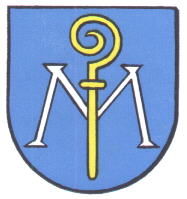Münster (Stuttgart): Difference between revisions
Jump to navigation
Jump to search
Knorrepoes (talk | contribs) No edit summary |
Knorrepoes (talk | contribs) m (Text replace - "[[Literature" to "{{media}} [[Literature") |
||
| Line 18: | Line 18: | ||
When the village required a new seal and arms in 1905 the State Archives proposed to add a crosier, and determine the colours as either silver on red or gold on blue. The stick is a symbol tot the Lorch Abbey, to which the village belonged from the 12<sup>th</sup> century onwards. The village decided upon the above colours. | When the village required a new seal and arms in 1905 the State Archives proposed to add a crosier, and determine the colours as either silver on red or gold on blue. The stick is a symbol tot the Lorch Abbey, to which the village belonged from the 12<sup>th</sup> century onwards. The village decided upon the above colours. | ||
{{media}} | |||
[[Literature]] : Bardua, 1973. | [[Literature]] : Bardua, 1973. | ||
Revision as of 01:57, 9 July 2014
| Heraldry of the World Civic heraldry of Germany - Deutsche Wappen (Gemeindewappen/Kreiswappen) |
MÜNSTER
State : Baden-Württemberg
District (Kreis) : Stuttgart
Incorporated into : 1931 Stuttgart
Origin/meaning
The oldest seal of Münster dates from 1611 and is thereby one of the oldest village seals in the area. It showed the letter M.
When the village required a new seal and arms in 1905 the State Archives proposed to add a crosier, and determine the colours as either silver on red or gold on blue. The stick is a symbol tot the Lorch Abbey, to which the village belonged from the 12th century onwards. The village decided upon the above colours.
Contact and Support
Partners:
Your logo here ?
Contact us
© since 1995, Heraldry of the World, Ralf Hartemink 
Index of the site
Literature : Bardua, 1973.











